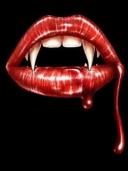

Vampires page 8
Rabies
Rabies has been linked with vampire folklore. Dr Juan Gףmez-Alonso, a neurologist at Xeral Hospital in Vigo, Spain, examined this possibility in a report in Neurology. The susceptibility to garlic and light could be due to hypersensitivity, which is a symptom of rabies. The disease can also affect portions of the brain that could lead to disturbance of normal sleep patterns (thus becoming nocturnal) and hypersexuality. Legend once said a man was not rabid if he could look at his own reflection (an allusion to the legend that vampires have no reflection). Wolves and bats, which are often associated with vampires, can be carriers of rabies. The disease can also lead to a drive to bite others and to a bloody frothing at the mouth.
Psychodynamic understanding
In his 1931 treatise On the Nightmare, Welsh psychoanalyst Ernest Jones noted that vampires are symbolic of several unconscious drives and defence mechanisms. Love, guilt, and hate are emotions that fuel the idea of the return of the dead to the grave. Desiring a reunion with loved ones, mourners may project the idea that the recently dead must in return yearn the same. From this arises the belief that folkloric vampires and revenants visit relatives, particularly their spouses, first. However in cases where there was unconscious guilt associated with the relationship, the wish for reunion may be subverted by anxiety. This may lead to repression, which Freud had linked with the development of morbid dread. Jones surmised in this case the original wish of a (sexual) reunion may be drastically changed: desire is replaced by fear; love is replaced by sadism, and the object or loved one is replaced by an unknown entity. The sexual aspect may or may not be present.
The innate sexuality of bloodsucking can be seen in its intrinsic connection with cannibalism and folkloric one with incubus-like behaviour. Many legends report various beings draining other fluids from victims, an unconscious association with semen being obvious. Finally Jones notes that when more normal aspects of sexuality are repressed, regressed forms may be expressed, in particular sadism; he felt that oral sadism is integral in vampiric behaviour.
Political interpretation
The reinvention of the vampire myth in the modern era is not without political overtones. The aristocratic Count Dracula, alone in his castle apart from a few demented retainers, appearing only at night to feed on his peasantry, is symbolic of the parasitic Ancien regime. Werner Herzog, in his Nosferatu the Vampyre, gives this political interpretation an extra ironic twist when his young estate agent hero becomes the next vampire; in this way the capitalist bourgeois becomes the next parasitic class.
Rabies has been linked with vampire folklore. Dr Juan Gףmez-Alonso, a neurologist at Xeral Hospital in Vigo, Spain, examined this possibility in a report in Neurology. The susceptibility to garlic and light could be due to hypersensitivity, which is a symptom of rabies. The disease can also affect portions of the brain that could lead to disturbance of normal sleep patterns (thus becoming nocturnal) and hypersexuality. Legend once said a man was not rabid if he could look at his own reflection (an allusion to the legend that vampires have no reflection). Wolves and bats, which are often associated with vampires, can be carriers of rabies. The disease can also lead to a drive to bite others and to a bloody frothing at the mouth.
Psychodynamic understanding
In his 1931 treatise On the Nightmare, Welsh psychoanalyst Ernest Jones noted that vampires are symbolic of several unconscious drives and defence mechanisms. Love, guilt, and hate are emotions that fuel the idea of the return of the dead to the grave. Desiring a reunion with loved ones, mourners may project the idea that the recently dead must in return yearn the same. From this arises the belief that folkloric vampires and revenants visit relatives, particularly their spouses, first. However in cases where there was unconscious guilt associated with the relationship, the wish for reunion may be subverted by anxiety. This may lead to repression, which Freud had linked with the development of morbid dread. Jones surmised in this case the original wish of a (sexual) reunion may be drastically changed: desire is replaced by fear; love is replaced by sadism, and the object or loved one is replaced by an unknown entity. The sexual aspect may or may not be present.
The innate sexuality of bloodsucking can be seen in its intrinsic connection with cannibalism and folkloric one with incubus-like behaviour. Many legends report various beings draining other fluids from victims, an unconscious association with semen being obvious. Finally Jones notes that when more normal aspects of sexuality are repressed, regressed forms may be expressed, in particular sadism; he felt that oral sadism is integral in vampiric behaviour.
Political interpretation
The reinvention of the vampire myth in the modern era is not without political overtones. The aristocratic Count Dracula, alone in his castle apart from a few demented retainers, appearing only at night to feed on his peasantry, is symbolic of the parasitic Ancien regime. Werner Herzog, in his Nosferatu the Vampyre, gives this political interpretation an extra ironic twist when his young estate agent hero becomes the next vampire; in this way the capitalist bourgeois becomes the next parasitic class.